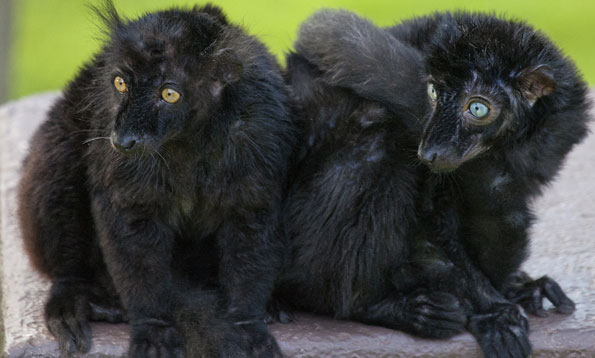Blue-eyed Black Lemur
Eulemur flavifrons

At the Zoo
The Zoo has seven different species of lemur in the Lipman Family Lemur Forest. This habitat features a lushly forested area and an elevated boardwalk to provide guests with exciting viewing perspectives of these lively prosimians.
Fascinating Facts
- Black lemurs exchange greetings through reciprocal fur grooming.
- Until 2008, the blue-eyed black lemur was considered a subspecies of the black lemur.
- They are important agents of seed dispersal in Madagascar through their droppings.
- Other than humans, blue-eyed black lemurs are the only primate to have blue eyes.
Physical Characteristics
Males and females of this lemur species look very different. Males are completely black and females are brownish grey or red with a dark muzzle. They average about 38 inches in length and weigh about five pounds. Black lemurs have long, bushy tails and a “fox-like” muzzle. Their usual mode of locomotion is on all fours, but they may assume an upright posture and move on their hind legs for brief periods of time. In the trees these lemurs are capable of leaping from branch to branch and even hanging upside down by their feet to feed.
Life span in the wild is 18 years, and 20-25 under human care.
Habitat/Diet
Black lemurs are extremely isolated to northwestern Madagascar on the Sahamalza Peninsula and a narrow strip of forest on the adjacent mainland. They inhabit both subtropical moist forests and dry deciduous forests.
They are largely arboreal and eat mostly fruit but will also consume leaves, flowers, and insects. At the Zoo, black lemurs eat fruit, leaves, monkey chow and dog chow.
Social Behavior
Black lemurs are gregarious animals. They travel in noisy bands of about 7–15 individuals, eating, sleeping and vocalizing together. Like many lemur species, they are matriarchal. Lemurs use several vocalizations for contact, greeting, territorial expression, threats and alarm. Like most prosimians, blue-eyed lemurs use scent markings as another method of communication. Scent marking is done by rubbing glands under the tail on their surroundings. In addition, males also mark with scent glands located on their hands and wrists and the top of their head.
They give birth approximately once a year to a single offspring, although twins do occur. For the first few weeks of life the baby will cling to the underside of the mother. Later on, it will ride on her back. Weaning usually occurs at about 135 days. Young are born reddish-brown and males will turn black between 16 and 32 days. Sexual maturity in females may be attained in 550 days, while males are ready to mate in approximately 900 days. The entire group helps care for and plays with the young.
Status In The Wild
Black lemurs are listed as critically endangered by the IUCN and are on appendix I of CITES. Their primary threat is deforestation due to slash-and-burn agriculture, logging and mining. They are also hunted for food and for the pet trade. Black lemurs are also killed by local farmers as they are known to occasionally raid crops.
Fortunately, black lemurs are adaptable and are able to live in disrupted forests and closer to human activities than other lemur species. Efforts are underway in AZA Zoos through a Species Survival Plan to increase their population to a self-sustaining level. Field studies are being conducted to provide information to increase public awareness about blue-eyed black lemurs as well.
The San Francisco Zoo & Gardens participates in the Association of Zoo and Aquarium’s Prosimian Taxon Advisory Group and the Malagasy Fauna Interest Group.
So, what can you do to help lemurs?
- Consider supporting conservation organizations working to save these magnificent animals.
- Spread the word about lemur conservation!
